|
|
|
Sort Order |
|
|
|
Items / Page
|
|
|
|
|
|
|
| Srl | Item |
| 1 |
ID:
166388
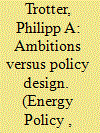

|
|
|
|
|
| Summary/Abstract |
Low energy access in sub-Saharan Africa has motivated the implementation of over 60 international electrification initiatives in the region. The US-led Power Africa initiative is one of the largest such efforts. Its central targets are to install 30 GW of additional capacity and create 60 million new connections to double electricity access by 2030. While Power Africa has received praise for its early achievements, an analysis of its targets and the rationale behind them reveals attributional, developmental and technical issues: Power Africa lacks a clear definition which criteria have to be met before African electrification projects can be counted towards fulfilling Power Africa's targets, the targets themselves appear to be too low to deliver on Power Africa's promises, and they exhibit several technical inconsistencies. Crucially, this paper argues that contrary to the Trump administration's intention to reduce its funds, Power Africa's targets and efforts need to be increased to meet the initiative's own ambitions.
|
|
|
|
|
|
|
|
|
|
|
|
|
|
|
|
| 2 |
ID:
166432


|
|
|
|
|
| Summary/Abstract |
This article examines China's Electric Power Law and the recent policies governing China's electricity sector from the energy-climate-environment dimension. Using the fragmented authoritarianism framework, it captures the legal system that is still rooted in the pre-reform era, and the antinomic policy making that is driven by the policy imperative to accommodate the shifting pattern of energy supply, the growing awareness over climate mitigation and environmental protection. By examining the most recent policy imperatives on regulating new investment and efficiency, and pricing deregulation, this article focuses on changes in the policy arena and their impacts on the regulatory governance of China's electricity sector. Using the methodology of qualitative study, this article critically investigates these policy changes that generate incompatible regulatory concerns. The incompatibility creates competing regulatory concerns over energy-climate-environment in the policy making process, and generates discord between China's central and provincial governments. Dealing with the challenges will depend on developing a legal framework for China's electricity sector. Findings of this article echoes with energy law scholars’ point of view that energy law has a much bigger role to play to balance different or competing policy agendas to deliver better energy policy that delivers the expected outcomes for society.
|
|
|
|
|
|
|
|
|
|
|
|
|
|
|
|
| 3 |
ID:
166408


|
|
|
|
|
| Summary/Abstract |
In 2015, ASEAN established a goal of increasing its renewable energy share in its energy portfolio from approximately 13–23% by 2025. Renewable electricity, especially intermittent and variable sources, presents challenges for grid operators due to the uncertain timing and quantity of electricity supply. Grid flexibility, the electric grid's ability to respond to changing demands and supply, now stands a key resource in responding to these uncertainties while maximizing the cost-effective role of clean energy. We develop and apply a grid flexibility assessment tool to assess ASEAN's current grid flexibility using six quantitative indicators: grid reliability, electricity market access; load profile ramp capacity; quality of forecasting tools; proportion of electricity generation from natural gas; and renewable energy diversity. We find that ASEAN nations cluster into three groups: better; moderately; and the least prepared nations. We develop an analytical ramp rate calculator to quantify expected load ramps for ASEAN in an integrated ASEAN Power Grid scenario. The lack of forecasting systems and limited electricity market access represent key weaknesses and areas where dramatic improvements can become cost-effective means to increase regional grid flexibility. As ASEAN pursues renewable energy targets, regional cooperation remains essential to address identified challenges. Member nations need to increase grid flexibility capacity to adequately prepare for higher penetrations of renewable electricity and lower overall system costs.
|
|
|
|
|
|
|
|
|
|
|
|
|
|
|
|
| 4 |
ID:
166354


|
|
|
|
|
| Summary/Abstract |
In 2017, Germany introduced auctions to determine the support level for onshore wind power. To protect small-scale actors, citizens’ energy cooperatives were allowed longer realization periods and did not need to have an approval pursuant to the Federal Immission Control Act to submit a bid. Winning cooperatives were given the highest accepted bid, while other participants were paid-as-bid. The aim of this paper is to examine how this auction design affected actor diversity and the risk of winning projects not being realized. Unexpectedly, the outcome of the auctions was that over 90% of the winners were cooperatives, and the average project size of their bids was twice the size of other winning bids. There was also a significant decrease in the highest accepted bid, from 5.78€ct/kWh in the first auction, to 3.82€ct/kWh in the third auction. However, the pricing rule combined with uncertain technology costs and strong competition, may have encouraged overly aggressive bidding. This, as well as cooperatives being exempt from having an approval pursuant to the Federal Immission Control Act, could increase the risk of winning projects not being realized. A conclusion is that special rules for small-scale actors, should be used with caution, especially if they give significant competitive advantages and may affect realization rates.
|
|
|
|
|
|
|
|
|
|
|
|
|
|
|
|
| 5 |
ID:
166429
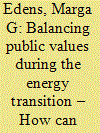

|
|
|
|
|
| Summary/Abstract |
Distribution of electricity constitutes an essential link in the energy sector value chain for which Distribution System Operators (DSOs) bear the responsibility. While executing that role, DSOs are expected to take into consideration public values, such as the availability, affordability and sustainability of the infrastructure they manage.
|
|
|
|
|
|
|
|
|
|
|
|
|
|
|
|
| 6 |
ID:
166363


|
|
|
|
|
| Summary/Abstract |
While the share of peat in Finland's energy mix today amounts to only around 4%, peat recurrently returns to the center stage in Finnish energy-related public debates. As an indigenous energy resource, peat is a welcome addition to the energy mix of the heavily energy-dependent country. In addition, the employment impacts of peat production are considered significant. These benefits are, however, contradicted by the environmental impacts and climate emissions caused by peat energy. The conflicting interests revolving around peat have resulted in constantly shifting national peat policies as well as infrequent “explosions” of public and political debates on peat production. This article explores two of the most recent politicizations of peat through an empirical focus on the short-lived promotion campaigns that sparked widespread public debate: the 2010 “2 prosenttia” [2%] internet campaign from the state-majority-owned energy company VAPO and the 2017 “Turveinfo” [peat info] campaign launched by The Bioenergy Association of Finland. Through an analysis of the colorful and provocative promotion campaigns, this article (1) explores the arguments and rhetoric through which political support of peat is being acquired from the Finnish public and (2) examines what crises in the 2010s Finland peat is constructed as the (only) logical answer for.
|
|
|
|
|
|
|
|
|
|
|
|
|
|
|
|
| 7 |
ID:
166370
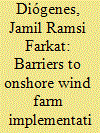

|
|
|
|
|
| Summary/Abstract |
Across the world, several developing countries with recent wind energy (WE) diffusion have been demonstrating an interest in expanding WE generation quickly and expressively. In Brazil, this fast and remarkable WE diffusion process started in the past decade, facing a variety of barriers. This research proposes to reliably identify and analyse current barriers to the implementation of onshore wind farms in the country, aiming at informing other developing countries with the intention to expand WE utilization about potential barriers, as well as assisting the Brazilian WE sector in its efforts to keep growing sustainably. To achieve this research goal, 41 key stakeholders from the Brazilian WE sector were interviewed. Based on a content analysis of the interviews, twenty-four barriers where identified, three of which with particular relevance: poor transmission infrastructure, unattractive financial loans and unstable macroeconomic environment. The data collected suggests a serious risk that Brazil's WE sector stops growing if the recovery of its national economy, the reestablishment of regular energy auctions, the access to competitive credit, and improvements to the transmission system infrastructure keep being held back. In the face of this scenario, this study concludes by providing policy recommendations concerning the sustainability of the Brazilian WE sector.
|
|
|
|
|
|
|
|
|
|
|
|
|
|
|
|
| 8 |
ID:
166403
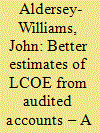

|
|
|
|
|
| Summary/Abstract |
Around the world, government policies to support new renewable energy technologies rely on accurate estimates of Levelised Cost of Energy (LCOE). This paper reveals that such estimates are based on “public domain” data which may be unreliable. A new approach and methodology has been developed which uses United Kingdom (UK) “audited” data, published in company accounts, that has been obtained from Companies House, to determine more accurate LCOE estimates. The methodology is applicable to projects configured within Special Purpose Vehicle (SPV) companies. The methodology is then applied to a number of UK offshore wind farms and one Combined Cycle Gas Turbine (CCGT) project to develop new cost data which is then compared to that presently in the public domain. The analysis reveals that recent offshore wind projects show a slightly declining LCOE and that public domain cost estimates are unreliable. But of most concern is that offshore wind farm costs are still much higher than those implied by recent bids for UK government financial support via Contracts for Difference (CfDs). The paper concludes by addressing further the question of how offshore wind projects can achieve the degree of LCOE reductions required by recent CfD bids.
|
|
|
|
|
|
|
|
|
|
|
|
|
|
|
|
| 9 |
ID:
166352
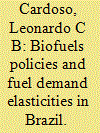

|
|
|
|
|
| Summary/Abstract |
Biofuels are often seen by policymakers as solutions to concerns about the environment, energy diversification, and rural development. To understand the impacts of biofuel policy, however, it is important to understand demand elasticities. Brazil, a leader in biofuels, provides a unique setting to increase our knowledge about biofuel policy and the interactions within and between the gasoline and ethanol markets. We estimate own-price, cross-price, and income elasticities of the demand for ethanol and gasoline using a novel instrumental variable approach to control for the inherent endogeneity between supply and demand. This results in own-price elasticities for both fuels higher than previous literature suggests: approximately − 0.9 for gasoline and − 1.5 for ethanol. Income elasticities for both fuels are approximately 0.8. We also examine the elasticity impacts following the introduction of flex-fuel cars into the Brazilian market. By estimating the model with over 100 subsamples across time, we find that cross-price elasticities become positive, significant, and increasing, but only after larger market penetration of flex-fuel cars, which occurred approximately three years after their introduction.
|
|
|
|
|
|
|
|
|
|
|
|
|
|
|
|
| 10 |
ID:
166406


|
|
|
|
|
| Summary/Abstract |
This study explores the effect of CSR on reducing a firm's stock price crash risk in China's energy industry by using a regression model and further investigates the effect of items within CSR (e.g., corporate governance and environment protection) on reducing said risk to find which item is important for CSR for the energy industry. Covering a total of 100 energy firms including electricity generation and mining from 2014 to 2016, this study observes that CSR significantly affects stock price crash risk in the energy industry, as employee protection, environmental protection, product quality control, consumers’ right protection, and supply chain partners all significantly reduce an energy firm's stock price crash risk. We also employ the industry as our moderator to test whether different sub-industries have varying correlations between CSR and stock price crash risk, finding that the electricity generation firms with higher CSR scores especially in environmental protection, promoting technology innovation, and corporate image have significantly lower stock price crash risk, while the mining firms do not. These results suggest that compared to other CSR items, investors should pay more attention on pollution improvement and trading provisions that decrease this risk more effectively, especially in the electricity generation industry.
|
|
|
|
|
|
|
|
|
|
|
|
|
|
|
|
| 11 |
ID:
166351
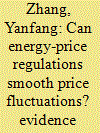

|
|
|
|
|
| Summary/Abstract |
Due to the dominance of coal in China’s energy mix, coal prices have always been a challenging part of pricing reform. The recent frequent government interventions raise the key research questions: what is the actual impact of price policies on coal price fluctuations, and how can forward-looking pricing policies be made. By proposing a novel classification of coal pricing policies and introducing an expectation and forward-looking coefficient, the paper examines the relationship between coal price fluctuations and pricing policies using the generalized method of moments (GMM) method. It shows that the lagging coal price and coal demand play a positive role in regulating coal prices, while coal supply and marketization have significantly negative effects on coal price fluctuations. The heterogeneous impacts of price policies are due to differences in market players’ expectations, policy instruments and the methods of policy release. In addition, China’s coal pricing policy portfolio from 2013 to 2016 exerted synergy effects on the restraint of coal price fluctuations. As the forward-looking coefficient was considerably low, the government's intervention behaviors were obviously biased towards ex post facto responses. The paper suggests short run and long run policies to advance marketization of coal prices amid the energy transition.
|
|
|
|
|
|
|
|
|
|
|
|
|
|
|
|
| 12 |
ID:
166343


|
|
|
|
|
| Summary/Abstract |
In the global specialization, a Global Value Chain (GVC) has been formed across economies. Countries are trying to improve the position of manufacturing in GVC to alleviate environmental constraints they faced. Based on the panel data of 60 countries in the world from 2000 to 2011, the carbon efficiency and the GVC position index are both evaluated, and the impact of position of manufacturing in GVC on carbon efficiency is further analyzed. Our results show that there is a significant positive correlation between them. Moreover, the impact is associated with the level of economic development, which means that promotion of the GVC embedding degree could optimize energy efficiency and reduce emissions more significantly in developing countries with relatively backward economies than in those developed countries. After further subdividing the manufacturing industry into three types: labor-intensive, resource-intensive and technology-intensive, we find that improving the position of the technology-intensive manufacturing industry in GVC has more significant positive effect on carbon efficiency than the other two types.
|
|
|
|
|
|
|
|
|
|
|
|
|
|
|
|
| 13 |
ID:
166386
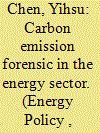

|
|
|
|
|
| Summary/Abstract |
Climate policy has mostly focused on regulating power suppliers. There is a growing interest in exploring regulating emissions from the demand side by incentivizing consumers to reduce their energy consumptions, or to purchase power from cleaner sources through tracking carbon content of power flow in the transmission network. This paper analyzes market outcomes under two approaches: producer-based and demand-based carbon taxes. We formulate each approach as a market equilibrium model. For the consumer-based approach, the analysis assumes that a utility, procuring electricity on behalf of consumers, is subject to the carbon tax. For the producer-based approach, the producers are subject to the carbon tax, and therefore, pay for their emissions. We show that the two approaches are equivalent when the program's coverage is complete. However, when the coverage is incomplete, the consumer-based carbon tax is less effective in pricing carbon emissions owing to the fact that sales to unregulated regions are not subject to the carbon tax. Given that the transaction cost of implementing consumer-based tax is likely to be high, benefit of tracking power flows in order to estimate carbon content or footprint might not be justified even with a full coverage program.
|
|
|
|
|
|
|
|
|
|
|
|
|
|
|
|
| 14 |
ID:
166433
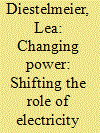

|
|
|
|
|
| Summary/Abstract |
One of the pressing legal questions of the energy transition is how to integrate “prosumers”, consumers who start producing electricity, in the electricity market. So far, their influence remains limited or fully absent because their role as independent market participants is barely or not facilitated as they are usually subject to regulated remuneration schemes. Blockchain technology offers changing the approach of “integration in the market” into “becoming the market” by enabling peer-to-peer transactions. Currently, transactions are facilitated by third parties, suppliers and system operators, whose main task is centrally compiling and coordinating information on loads and generation and contracting supply and distribution services. Instead, blockchain technology enables new ways of organising decentralised persons without the immediate need for one centrally connecting entity. This implies profound legal- and policy consequences. Based on information on first use cases of blockchain applications in the electricity sector, this article identifies those main policy implications for EU electricity law and thereby adds to the discussion how blockchain technology could facilitate “prosumers” to develop as independent market participants in the electricity sector from an energy law perspective.
|
|
|
|
|
|
|
|
|
|
|
|
|
|
|
|
| 15 |
ID:
166392


|
|
|
|
|
| Summary/Abstract |
Climate change is likely to affect water availability and therefore hydropower generation in many regions of the world. In drying regions, hydropower generation may be impaired, creating a need for new power investments that would otherwise have been unnecessary. In this study we apply two partial equilibrium models (GCAM and TIAM-ECN) and two general equilibrium models (MEG4C and Phoenix) to identify possible pathways of power sector adaptation for Colombia under climate change. We adopt two GCM projections that deteriorate hydropower generation over the next three decades, and simulate each for two radiative forcing scenarios (RCP8.5 and RCP4.5). Relative to Colombia's projected power demand growth over the coming decades, losses in hydropower generation are marginal. Nonetheless, climate-driven losses in hydropower must be compensated by alternative technologies´expansion, which vary significantly across models. When climate policy is implemented (RCP4.5), three distinct expansion pathways emerge: increased solar and wind energy (TIAM-ECN); significant power demand reductions (Phoenix and MEG4C); and increased fossil resources with carbon dioxide capture and storage (GCAM). We show the need to explore the tradeoffs/synergies among alternative expansion pathways and their potential impacts on other sectors (e.g. water and land), and for effective policies to incentivize their adoption in Colombia.
|
|
|
|
|
|
|
|
|
|
|
|
|
|
|
|
| 16 |
ID:
166348


|
|
|
|
|
| Summary/Abstract |
Biomass utilization is a strategy to decrease greenhouse gas (GHG) emissions in the European Union (EU) but bioenergy in the United States (US) is currently limited. As a result, biomass is increasingly exported from the US to the EU, but changes to the policy landscape are poised to alter this. This study utilizes Life Cycle Assessment (LCA) to assess impacts of biomass transportation on bioenergy life cycle GHG emissions. Transportation modes considered include truck, train and sea freight and each are assessed at realistic distances expected in bioenergy supply chains. Emissions for biomass firing alone and co-firing with coal using wood chips and pellets are compared to a baseline coal-fired power plant. Results include life cycle emissions for each case, and sensitivity analysis is presented for variation in power plant efficiency and biomass heating value. A generalized model for estimation of bioenergy emissions is presented. In nearly all cases, biomass utilization for electricity production produces lower life cycle GHG emissions compared to the coal baseline, with emission reductions as high as 76%. Utilization in the US and EU have similar overall emissions at long US distances. Policy implications are discussed in the context of current US and EU policies.
|
|
|
|
|
|
|
|
|
|
|
|
|
|
|
|
| 17 |
ID:
166361


|
|
|
|
|
| Summary/Abstract |
This study evaluates the distribution of electricity subsidies to residential customers in Addis Ababa, Ethiopia in 2016 that results from the current increasing block tariff (IBT) structure. Customer billing data supplied by the electricity utility were matched with socioeconomic information collected from a survey of 987 households, and used with a utility-specific estimate of the costs of electricity service to estimate household-specific subsidies. The analysis differentiates between primary customers, who own an electricity account, and nonprimary customers, who pay a primary account holder, and presents the first detailed analysis of the incidence of subsidies provided to households with private versus shared electricity connections. Results show that households in the poorest quintile received 7% of the total subsidy, while households in the wealthiest quintile received 37%. The majority of households with shared connections were in poorer quintiles, and 80% in the poorest quintile were nonprimary customers. The regressive outcomes of the IBT structure are explained by two of its attributes: (1) the volumetric rates in all tariff blocks are substantially below the total average cost of delivery of the service; and (2) there is only a moderate association between electricity consumption and household wealth.
|
|
|
|
|
|
|
|
|
|
|
|
|
|
|
|
| 18 |
ID:
166381
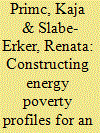

|
|
|
|
|
| Summary/Abstract |
Energy poverty is becoming ever more important for academia and policymakers. This study conducts fuzzy-set qualitative comparative analysis (fsQCA) with the aim of constructing energy poverty profiles. FsQCA was performed on 150 households. The results show that energy-poor households are characterised by the interdependence and intertwining of socio-demographic (ownership status, education level, labour force status and household size) and housing (type of building, central heating system and solar collectors/heat pump) characteristics. The conditions form eight equifinal configurations related to energy-poor households. None of the individual characteristics is able to explain energy poverty alone, although strong interrelations are present in the outcomes. The study also highlights that the conditions play different roles in the presence or absence of energy poverty, giving policymakers the necessary leeway to formulate effective policies as part of agendas covering poverty in general, poor health, climate change and domestic energy inefficiency. This study suggests that energy poverty is a structural issue, mainly arising from poor energy-efficient buildings and/or labour market inefficiencies.
|
|
|
|
|
|
|
|
|
|
|
|
|
|
|
|
| 19 |
ID:
166389
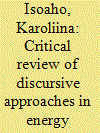

|
|
|
|
|
| Summary/Abstract |
This article critically reviews the use of discursive approaches in studies of sustainable energy transitions. The review is motivated by calls to further incorporate social scientific methodologies into energy research and assess their contribution to policy. We strive to answer three questions: (1) which discursive approaches have been used to study sustainable energy transitions; (2) what thematic topics and issue areas have been covered and (3) what is the added value of discursive research designs? Our analysis is based on a review of 77 articles from the years 2004–2016. Our findings show that discursive approaches were mostly used to analyse institutional change and policy strategies at the national level and to examine energy choices through political ideology and the perceptions of publics. Nuclear power received most coverage, while renewable energy technologies were mainly studied through conflicts and opposition. We demonstrate discursive research designs to examine four distinct policy areas and discuss the added value of these approaches for energy policy and research. Discursive methodologies enable scholars to enrich policy discussions through accounting for transitions as complex and dynamic processes of change.
|
|
|
|
|
|
|
|
|
|
|
|
|
|
|
|
| 20 |
ID:
166431
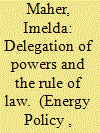

|
|
|
|
|
| Summary/Abstract |
This article examines the legal frameworks surrounding the EU energy policy and its associated institutional architecture. Particular focus is on the Agency for Cooperation of Energy Regulators (ACER). Taking stock of ongoing debates concerning the Energy Union and recently proposed reforms, the purpose of this analysis is twofold. First, from a theoretical perspective, this article explores the limits of the principal/agent model for European integration after the Treaty of Lisbon. It argues that a rule of law analysis should supplement this model in order to improve the encapsulation of the complexities of delegation in policy areas such as energy. Second, this will enable a reflection on the principle of energy justice and the way in which it is articulated by policy and governance changes in the EU.
|
|
|
|
|
|
|
|
|
|
|
|
|
|
|
|
|
|
|
|
|